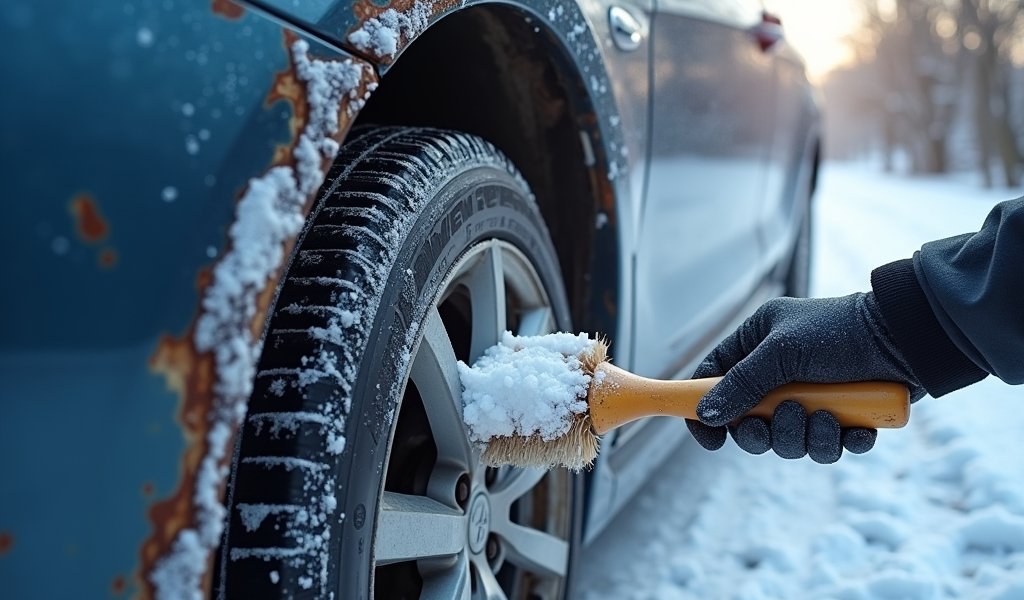Overview
This article outlines a five-step strategy to protect vehicles from road salt damage: thorough pre-winter cleaning, applying protective coatings, undercarriage protection, regular winter washing every 10-14 days, and interior protection with quality floor mats and fabric protectants. These preventative measures help maintain vehicle safety, reliability, and resale value while preventing costly repairs caused by salt corrosion on metal components.
Table of Contents
- Understanding Road Salt Damage
- Step 1: Thorough Cleaning Before Winter
- Step 2: Apply Protective Coating
- Step 3: Undercarriage Protection
- Step 4: Regular Winter Washing
- Step 5: Interior Protection
- Conclusion
- Frequently Asked Questions
Understanding Road Salt Damage
Road salt is a double-edged sword for winter drivers. While it helps keep our roads safe by melting ice and improving traction, it’s also silently attacking your vehicle’s metal components. I’ve spent over 20 years as an automotive technician, and I can tell you that learning how to prepare your car for road salt is one of the most valuable skills any vehicle owner can develop.
Salt accelerates the oxidation process (that’s rust, in simple terms) by lowering the freezing point of water and creating an electrolyte solution that essentially turns your car’s metal surfaces into a weak battery. This electrochemical reaction eats away at your vehicle’s undercarriage, brake lines, exhaust system, and body panels.
The damage isn’t just cosmetic. I’ve seen salt corrosion compromise structural integrity, create dangerous brake line failures, and lead to exhaust leaks. The average repair bill for extensive salt damage can easily run into thousands of dollars. But here’s the good news: with proper preparation, you can significantly reduce your vehicle’s vulnerability.
Step 1: Thorough Cleaning Before Winter
Before you can protect your vehicle, you need a clean slate to work with. Think of this like preparing skin before applying sunscreen – any dirt or contaminants will prevent protective products from properly adhering to surfaces.
Start with a thorough exterior wash, but don’t stop at the visible surfaces. Pay special attention to these often-overlooked areas:
- Wheel wells and inside fender liners
- Behind bumpers and splash guards
- Rocker panels and lower door edges
- Drain holes along door bottoms and in the trunk/hatch area
- Engine bay (focus on metal components, being careful around electronics)
Use a pressure washer if available, but be careful not to damage seals or force water into electrical components. A garden hose with a high-pressure nozzle works well too. For truly effective rust prevention, consider paying for a professional detailing service before winter sets in.
While cleaning, inspect for any existing rust spots. Even small spots should be addressed now, as road salt will accelerate their growth exponentially. For small surface rust, use a wire brush to remove loose material, then apply a rust converter product before protecting the area. According to Consumer Reports, addressing minor rust early can prevent major structural issues later.

Step 2: Apply Protective Coating
With your vehicle clean and free of existing rust, it’s time to apply a protective barrier. This layer will serve as your first line of defense against salt’s corrosive effects.
For painted surfaces, apply a high-quality carnauba wax or synthetic sealant. Synthetic sealants generally last longer (2-3 months versus 4-6 weeks for natural wax) and provide superior protection in harsh winter conditions. For maximum protection, consider having a ceramic coating professionally applied – these can last 1-2 years and create an extremely durable barrier.
When applying wax or sealant:
- Work in small sections, following product directions
- Pay extra attention to lower body panels that receive the most salt exposure
- Don’t forget door jambs, hood edges, and trunk/hatch seams
- Apply two thin coats for better coverage than one thick coat
- Allow proper curing time between applications
For chrome or exposed metal parts like bumpers, grilles, and trim pieces, use a dedicated metal protectant. These products deposit a thin, clear film that prevents salt from directly contacting the metal surface.
Don’t overlook your wheels! Aluminum alloy wheels are particularly vulnerable to salt damage. After cleaning thoroughly, apply a wheel-specific sealant that can withstand high temperatures and provide lasting protection. In my experience, this simple step can keep your wheels looking new for years longer.
Step 3: Undercarriage Protection
The underside of your vehicle takes the worst beating from road salt, yet it’s the area most owners neglect. This is where I see the most serious (and expensive) salt damage in my shop.
Several effective undercarriage protection options exist:
- Oil-based spray undercoating: Creates a protective barrier that salt can’t penetrate. It needs reapplication annually but offers excellent protection.
- Rubberized undercoating: Provides longer-lasting protection but must be applied properly to prevent trapping moisture.
- Wax-based products: Less messy than oil sprays and can be applied at home with the right equipment.
If applying yourself, focus on these critical components:
- Frame rails and crossmembers
- Brake lines and fuel lines
- Suspension components and control arms
- Subframe connections and mounting points
- Exhaust system hangers and heat shields
Many professional shops offer undercarriage protection services for $150-300, which is money well spent considering the cost of repairs from salt damage. If you’re winterizing your car on a budget, at minimum, use a garden hose attachment to spray the undercarriage thoroughly after each snowfall or salt application.
A study from the National Association of Corrosion Engineers found that vehicles in heavy salt-use regions can lose up to 10% of their structural integrity within just 5-7 years without proper protection. That’s not just costly—it’s potentially dangerous.
Step 4: Regular Winter Washing
Pre-winter preparation is crucial, but maintaining that protection throughout the season is equally important. Regular washing is your most effective ongoing defense against salt damage.
During heavy salting periods, I recommend washing your vehicle every 10-14 days, even in cold weather. Here’s how to maximize these winter washes:
- Choose days when temperatures are above freezing if possible
- Always select the undercarriage spray option at automatic car washes
- Pay extra for the spot-free rinse to prevent water spots from forming
- Dry door jambs, locks, and weather stripping thoroughly to prevent freezing
- If washing at home, add a tablespoon of baking soda to your wash solution to help neutralize salt
After washing, apply a quick-detail spray to maintain your protective coating between waxing sessions. These products take just minutes to apply and provide significant additional protection.
Don’t forget to flush out wheel wells and other areas where salt collects. A simple garden hose spray can dislodge accumulated salt before it has time to do damage. I’ve saved countless vehicles from premature rust by emphasizing this simple maintenance step to my customers.
If you’ve invested in essential winter car maintenance, don’t undermine your efforts by skipping regular washes. It’s the consistency that pays dividends in vehicle longevity.

Step 5: Interior Protection
Salt damage isn’t limited to your car’s exterior. Salt tracked in on shoes and boots can deteriorate floor mats, carpeting, and eventually the metal beneath them. This often-overlooked aspect of salt protection deserves your attention.
Start with quality all-weather floor mats designed to contain melting snow and salt. Look for designs with raised edges that prevent salty slush from seeping onto your carpets. Clean these mats weekly during winter months, as salt left sitting on rubber or vinyl can eventually cause drying and cracking.
For fabric protection:
- Apply a fabric protectant spray to carpets and cloth seats
- Vacuum interior surfaces frequently to remove salt particles
- Wipe down door sill plates where salt accumulates as passengers enter and exit
- Use a damp cloth on vinyl and leather surfaces, followed by an appropriate conditioner
Don’t overlook your door jambs and weatherstripping. Salt can accumulate here and cause premature deterioration of seals and hinges. A quick wipe with a damp cloth followed by a silicone-based protectant can prevent expensive damage and those annoying winter wind noises caused by deteriorated seals.
Electronics are also vulnerable to salt damage. Keep charging ports, connections, and dashboard buttons clean and free from salt residue that can cause corrosion and electrical failures.
Conclusion
Protecting your vehicle from road salt isn’t just about preserving its appearance – it’s about maintaining safety, reliability, and resale value. As someone who’s repaired thousands of salt-damaged vehicles, I can confidently say that prevention is infinitely more affordable than repair.
The five steps we’ve covered create a comprehensive defense system:
- Start with thorough cleaning
- Apply protective coatings
- Protect your undercarriage
- Maintain regular washing
- Don’t forget interior protection
Remember that consistency is key. Even the best pre-winter preparation will need maintenance throughout the season. By following these guidelines and making salt protection part of your regular winter car care routine, you’ll extend your vehicle’s life by years and save thousands in potential repairs.
Your vehicle is likely one of your largest investments. A few hours of preventative care each season represents an excellent return on that investment. And there’s something deeply satisfying about emerging from winter with a vehicle that looks almost as good as it did when the first snowflake fell.
Frequently Asked Questions
How often should I wash my car during winter salt season?
Wash your car every 10-14 days during active salt application periods. Increase frequency to weekly if you frequently drive on heavily salted roads or highways.
Can I apply undercoating to my car myself?
Yes, DIY undercoating products are available, but professional application often provides better coverage of vulnerable areas. Ensure proper preparation and follow all product instructions if doing it yourself.
Will regular waxing really protect against salt damage?
Regular waxing creates a hydrophobic barrier that significantly reduces salt’s ability to contact your paint and initiate corrosion. For best results, apply before winter begins and reapply mid-season.
What’s the most critical area to protect from salt damage?
The undercarriage experiences the most direct salt exposure and contains vital components like brake lines and fuel lines. Prioritize undercarriage protection for safety and structural integrity.
Does salt damage newer cars less than older models?
Modern vehicles typically have better factory corrosion protection, but all cars remain vulnerable to salt damage. Even new vehicles benefit from additional protection in regions where road salt is heavily used.

